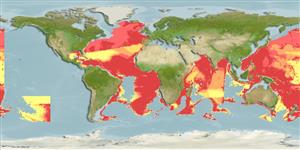>
Ophidiiformes (Cusk eels) >
Ophidiidae (Cusk-eels) > Neobythitinae
Etymology: Lamprogrammus: Greek, lampros = light + Greek, gramma = letter, signal (Ref. 45335); niger: Named after its black body color (Ref. 4525).
More on author: Alcock.
Environment: milieu / climate zone / depth range / distribution range
पारिस्थितिकी
समुद्री बैथीपिलाजिक; गहराई सीमा 741 - 2000 m (Ref. 3686), usually ? - 1500 m (Ref. 34024). Deep-water
Circumtropical, sometimes found in subtropical areas.
आकार / वज़न / Age
Maturity: Lm ? range ? - ? cm
Max length : 61.0 cm SL पुल्लिंग / अलिंग; (Ref. 3686)
Short description
पहचान कुंजी | आकृति विज्ञान | मौरफोमैटरिक्स
पृष्ठीय रीढ़ (सम्पूर्ण) : 0; पृष्ठीय सौफट रेज़ (सम्पूर्ण) : 105 - 115; गुदा कांटा: 0; ऐनल सौफट रेज़: 84 - 91.
Small specimens caught in midwater trawls (Ref. 34024). Oviparous, with oval pelagic eggs floating in a gelatinous mass (Ref. 205).
Life cycle and mating behavior
Maturities | पुनरुत्पत्ति | Spawnings | Egg(s) | Fecundities | लार्वा
Nielsen, J.G., D.M. Cohen, D.F. Markle and C.R. Robins, 1999. Ophidiiform fishes of the world (Order Ophidiiformes). An annotated and illustrated catalogue of pearlfishes, cusk-eels, brotulas and other ophidiiform fishes known to date. FAO Fish. Synop. 125(18):178p. Rome: FAO. (Ref. 34024)
IUCN Red List Status (Ref. 130435)
Threat to humans
Harmless
Human uses
मात्स्यिकी: कोई रुचि बग़ैर
साधन
Special reports
Download XML
इंटरनेट स्रोत
Estimates based on models
Preferred temperature (Ref.
123201): 2.5 - 6.7, mean 4.3 °C (based on 1622 cells).
Phylogenetic diversity index (Ref.
82804): PD
50 = 0.5312 [Uniqueness, from 0.5 = low to 2.0 = high].
Bayesian length-weight: a=0.00110 (0.00041 - 0.00296), b=3.08 (2.85 - 3.31), in cm total length, based on LWR estimates for this (Sub)family-body shape (Ref.
93245).
Trophic level (Ref.
69278): 3.7 ±0.6 se; based on size and trophs of closest relatives
लौटाव (Ref.
120179): माध्यम, न्यूनतम जनसंख्या दुगनी होने का समय 1.4 - 4.4 वर्ष। (Preliminary K or Fecundity.).
Fishing Vulnerability (Ref.
59153): Moderate to high vulnerability (50 of 100).
